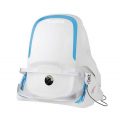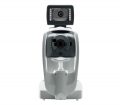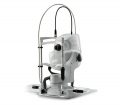-
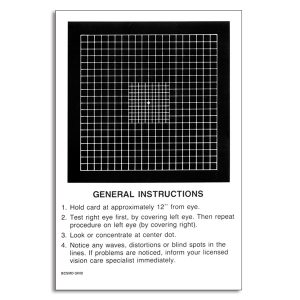 Refined Central Amsler Grid Amsler grid pad with additional lines at the central fixation point for testing and monitoring macular problems. Pad of 50 sheets
Refined Central Amsler Grid Amsler grid pad with additional lines at the central fixation point for testing and monitoring macular problems. Pad of 50 sheets -
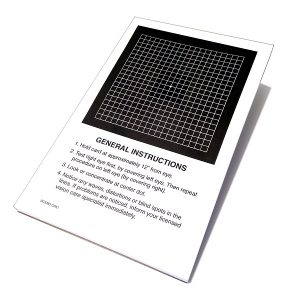 ARMD Test Pad Amsler grid pad for testing and monitoring macular problems. Ideal for patients to take home. Heavy, non-wrinkle paper Pad of 50 sheets
ARMD Test Pad Amsler grid pad for testing and monitoring macular problems. Ideal for patients to take home. Heavy, non-wrinkle paper Pad of 50 sheets -
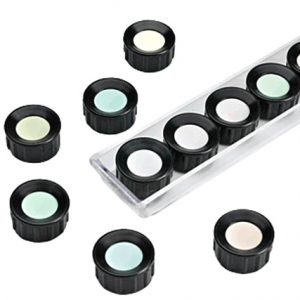 Anthony 15 Hue-Test Desaturated Test revels color blindness by using light hues. Diagnoses abnormal congentia, trichromats, and dyschromatopsia.
Anthony 15 Hue-Test Desaturated Test revels color blindness by using light hues. Diagnoses abnormal congentia, trichromats, and dyschromatopsia. -
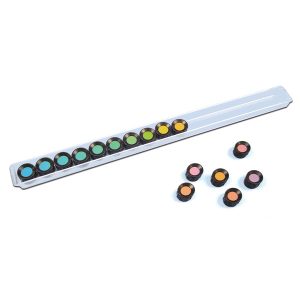 Farnsworth D15 Dichotomous Color Test Farnsworth Test for Congenital and Acquired color defects. The Farnsworth D-15 contains a reference disc holding notation 10 B 5 4 and fifteen numbered discs which make up an incomplete color circle. The patient arranges the discs and then evaluation of the patients arrangement separates 'normal' color perception from moderate and strong defects in deutan, protan or tritan axis color discrimination. The D-15 is housed in a plexiglass container. the disks are spread out on a table and arranged by the patient. The Farnsworth D-15 test is a subset of the well known Farnsworth 100 Hue Test. It is intended for classification instead of in-depth study of color vision defects. The D-15 and 100 hue tests are correlated. Growing Importance of Color deficiency Screening. In addition to congenital color deficiency screening there is growing evidence that adult acquired color deficiency, especially in yellow and blue perception, can indicate medical toxicity and other problems. Increasingly complex security and medical systems also require verification of all three types of color receptors. How the D-15 test works: The Farnsworth D15 is called 'dichotomous' because it is designed to separate subjects into one of two groups, 1) Strongly color deficient or 2) Mildly color deficient or color normal. This is accomplished by the arrangement of vivid (saturated) colored discs. A perfect score shows normal color perception. A non-perfect score is used to determine a medium or strong color deficiency.
Farnsworth D15 Dichotomous Color Test Farnsworth Test for Congenital and Acquired color defects. The Farnsworth D-15 contains a reference disc holding notation 10 B 5 4 and fifteen numbered discs which make up an incomplete color circle. The patient arranges the discs and then evaluation of the patients arrangement separates 'normal' color perception from moderate and strong defects in deutan, protan or tritan axis color discrimination. The D-15 is housed in a plexiglass container. the disks are spread out on a table and arranged by the patient. The Farnsworth D-15 test is a subset of the well known Farnsworth 100 Hue Test. It is intended for classification instead of in-depth study of color vision defects. The D-15 and 100 hue tests are correlated. Growing Importance of Color deficiency Screening. In addition to congenital color deficiency screening there is growing evidence that adult acquired color deficiency, especially in yellow and blue perception, can indicate medical toxicity and other problems. Increasingly complex security and medical systems also require verification of all three types of color receptors. How the D-15 test works: The Farnsworth D15 is called 'dichotomous' because it is designed to separate subjects into one of two groups, 1) Strongly color deficient or 2) Mildly color deficient or color normal. This is accomplished by the arrangement of vivid (saturated) colored discs. A perfect score shows normal color perception. A non-perfect score is used to determine a medium or strong color deficiency. -
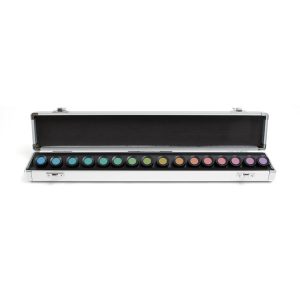 Farnsworth Test for Congenital and Acquired color defects. The Farnsworth D-15 contains a reference disc holding notation 10 B 5 4 and fifteen numbered discs which make up an incomplete color circle. The patient arranges the discs and then evaluation of the patients arrangement separates 'normal' color perception from moderate and strong defects in deutan, protan or tritan axis color discrimination. The disks are spread out on a table and arranged by the patient. The Farnsworth D-15 test is a subset of the well known Farnsworth 100 Hue Test. It is intended for classification instead of in-depth study of color vision defects. The D-15 and 100 hue tests are correlated. Growing Importance of Color deficiency Screening: In addition to congenital color deficiency screening there is growing evidence that adult acquired color deficiency, especially in yellow and blue perception, can indicate medical toxicity and other problems. Increasingly complex security and medical systems also require verification of all three types of color receptors. How the D-15 test works: The Farnsworth D15 is called 'dichotomous' because it is designed to separate subjects into one of two groups, 1) Strongly color deficient or 2) Mildly color deficient or color normal. This is accomplished by the arrangement of vivid (saturated) colored discs. A perfect score shows normal color perception. A non-perfect score is used to determine a medium or strong color deficiency.
Farnsworth Test for Congenital and Acquired color defects. The Farnsworth D-15 contains a reference disc holding notation 10 B 5 4 and fifteen numbered discs which make up an incomplete color circle. The patient arranges the discs and then evaluation of the patients arrangement separates 'normal' color perception from moderate and strong defects in deutan, protan or tritan axis color discrimination. The disks are spread out on a table and arranged by the patient. The Farnsworth D-15 test is a subset of the well known Farnsworth 100 Hue Test. It is intended for classification instead of in-depth study of color vision defects. The D-15 and 100 hue tests are correlated. Growing Importance of Color deficiency Screening: In addition to congenital color deficiency screening there is growing evidence that adult acquired color deficiency, especially in yellow and blue perception, can indicate medical toxicity and other problems. Increasingly complex security and medical systems also require verification of all three types of color receptors. How the D-15 test works: The Farnsworth D15 is called 'dichotomous' because it is designed to separate subjects into one of two groups, 1) Strongly color deficient or 2) Mildly color deficient or color normal. This is accomplished by the arrangement of vivid (saturated) colored discs. A perfect score shows normal color perception. A non-perfect score is used to determine a medium or strong color deficiency. -
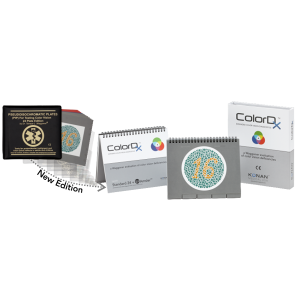 Same great test as before, but with a new and improved package! One of only two color vision tests validated and required for Naval Aviators. ColorDx is new brand identity for the proven Waggoner six confusion-color strategy used by physicians, Ophthalmologists, Optometrists, and nurses worldwide. This military grade test is used by the US Army and for FAA annual flight physicals requiring color vision testing and has been independently validated by both academic institutions and military services. This new edition features enhanced digital colorimetery production methods, durable page and binding materials, and magnetic light-protective storage case. The ColorDx Standard 24 is designed and licensed from color vision expert Dr. Terrace Waggoner and is the newest edition of the Waggoner PIP-24 (PIPIC 24).
Same great test as before, but with a new and improved package! One of only two color vision tests validated and required for Naval Aviators. ColorDx is new brand identity for the proven Waggoner six confusion-color strategy used by physicians, Ophthalmologists, Optometrists, and nurses worldwide. This military grade test is used by the US Army and for FAA annual flight physicals requiring color vision testing and has been independently validated by both academic institutions and military services. This new edition features enhanced digital colorimetery production methods, durable page and binding materials, and magnetic light-protective storage case. The ColorDx Standard 24 is designed and licensed from color vision expert Dr. Terrace Waggoner and is the newest edition of the Waggoner PIP-24 (PIPIC 24). -
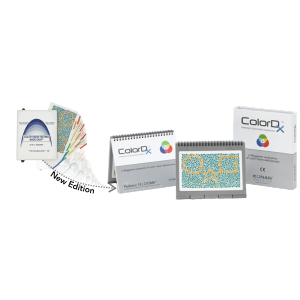 Same great test, but in a new and improved package! The ColorDx Pediatric 15 is the newest version of Color Vision Testing Made Easy or CVTME. As the Gold Standard pediatric assessment of color deficiencies or color blindness See The Multi-Ethnic Pediatric Eye Disease Study published by the AAO, CVTME™ is used in over 40 countries and has been validated for illiterates at the US Special Olympics. Featuring the proven Waggoner six confusion-color strategy, the pediatric test is used in a broad range of settings: pediatrics, eye physicians, school nurses, and many other disciplines of health care, in any language, world-wide. This easy to administer test features both hidden and non-hidden shapes that allow for positive reinforcement even while testing color deficient children by allowing successful answers on most targets. This success-reinforced strategy is also useful for assessment of malingering. Designed by color vision expert Dr. Terrace Waggoner, this new edition features enhanced digital colorimetery production methods, durable page and binding materials, and magnetic light-protective storage case and enhanced digital colorimetery production method and durable page materials and binding. Brilliantly simple to take, easy to score and just plain fun for children.
Same great test, but in a new and improved package! The ColorDx Pediatric 15 is the newest version of Color Vision Testing Made Easy or CVTME. As the Gold Standard pediatric assessment of color deficiencies or color blindness See The Multi-Ethnic Pediatric Eye Disease Study published by the AAO, CVTME™ is used in over 40 countries and has been validated for illiterates at the US Special Olympics. Featuring the proven Waggoner six confusion-color strategy, the pediatric test is used in a broad range of settings: pediatrics, eye physicians, school nurses, and many other disciplines of health care, in any language, world-wide. This easy to administer test features both hidden and non-hidden shapes that allow for positive reinforcement even while testing color deficient children by allowing successful answers on most targets. This success-reinforced strategy is also useful for assessment of malingering. Designed by color vision expert Dr. Terrace Waggoner, this new edition features enhanced digital colorimetery production methods, durable page and binding materials, and magnetic light-protective storage case and enhanced digital colorimetery production method and durable page materials and binding. Brilliantly simple to take, easy to score and just plain fun for children. -
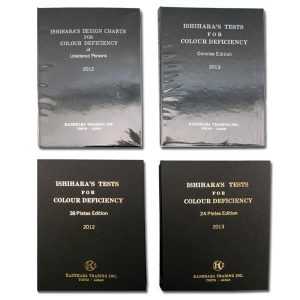
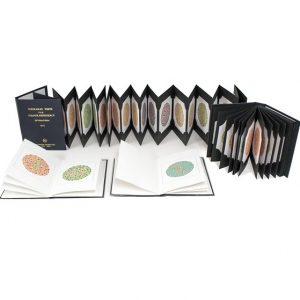 Ishihara Pseudo-Isochromatic Test The most widely used standard of color vision screening in a book form. Instructions Included.
Ishihara Pseudo-Isochromatic Test The most widely used standard of color vision screening in a book form. Instructions Included. -
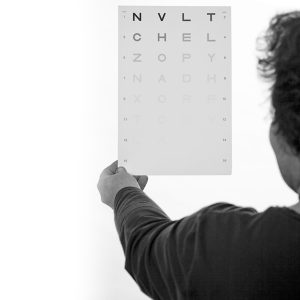
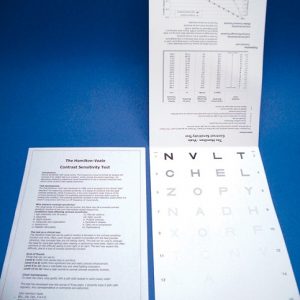 Hamilton-Veale Contrast Sensitivity Test This easy and convenient test can be used to monitor a decrease on the contrast sensitivity function over time. This test also demonstrates the difficulty of seeing in poor lighting or at night.
Hamilton-Veale Contrast Sensitivity Test This easy and convenient test can be used to monitor a decrease on the contrast sensitivity function over time. This test also demonstrates the difficulty of seeing in poor lighting or at night. -
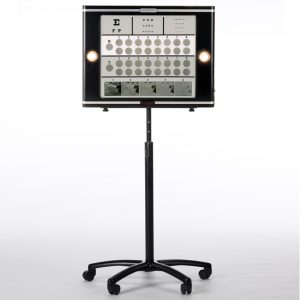 VectorVision Contrast Sensitivity Testing Unit (Includes Testing Box and Test Chart) The VV1000 is used clinically by eye doctors in over 45 countries to evaluate cataracts, glaucoma, diabetic eye disease, contact lens performance, refractive surgery, etc. In addition, the instrument has been selected for use in numerous multi-center trials for the evaluation of contrast sensitivity, ETDRS acuity, low contrast acuity and glare sensitivity. These studies include those for PRK refractive surgery, contact lens evaluation, LASIK refractive surgery, athlete visual performance, visual impact of pharmaceutical treatments, etc. The patented CSV-1000 standardization insures that testing light levels do not vary due to changes in line voltage or due to bulb aging. No other vision testing instrument offers this standardization package. The VV1000 is the only self-standardized vision testing instrument. In each row of the device, photocell circuitry continually monitors and calibrates the instrument light level. This unique system senses both the external light striking the face of the instrument and the internal light which emanates from the miniature fluorescent bulbs. By measuring both light sources, the patented circuitry (U.S. Patent Number 5,078,486) determines the total light reflected from the instrument face and provides for a constant test luminance level of 85 cd/m2. The CSV-1000 is operated by wireless remote control so that each row of the instrument can be individually lighted for easier viewing by the patient. The VV1000 can be used with a variety of tests. The VV-1000 can easily rest on a table, hang on the wall or be used with rolling floor stand. The instrument can be easily transported from office to office or to out-of-office screening locations.
VectorVision Contrast Sensitivity Testing Unit (Includes Testing Box and Test Chart) The VV1000 is used clinically by eye doctors in over 45 countries to evaluate cataracts, glaucoma, diabetic eye disease, contact lens performance, refractive surgery, etc. In addition, the instrument has been selected for use in numerous multi-center trials for the evaluation of contrast sensitivity, ETDRS acuity, low contrast acuity and glare sensitivity. These studies include those for PRK refractive surgery, contact lens evaluation, LASIK refractive surgery, athlete visual performance, visual impact of pharmaceutical treatments, etc. The patented CSV-1000 standardization insures that testing light levels do not vary due to changes in line voltage or due to bulb aging. No other vision testing instrument offers this standardization package. The VV1000 is the only self-standardized vision testing instrument. In each row of the device, photocell circuitry continually monitors and calibrates the instrument light level. This unique system senses both the external light striking the face of the instrument and the internal light which emanates from the miniature fluorescent bulbs. By measuring both light sources, the patented circuitry (U.S. Patent Number 5,078,486) determines the total light reflected from the instrument face and provides for a constant test luminance level of 85 cd/m2. The CSV-1000 is operated by wireless remote control so that each row of the instrument can be individually lighted for easier viewing by the patient. The VV1000 can be used with a variety of tests. The VV-1000 can easily rest on a table, hang on the wall or be used with rolling floor stand. The instrument can be easily transported from office to office or to out-of-office screening locations. -
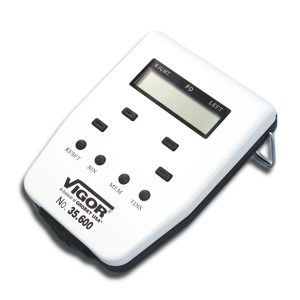 Look more modern while improving your accuracy and decreasing remakes with your PAL's. This digital pupilometer is easy to use. Requires 4 AA batteries (not included).
Look more modern while improving your accuracy and decreasing remakes with your PAL's. This digital pupilometer is easy to use. Requires 4 AA batteries (not included). -
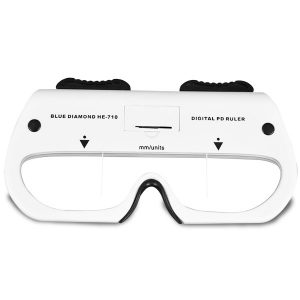
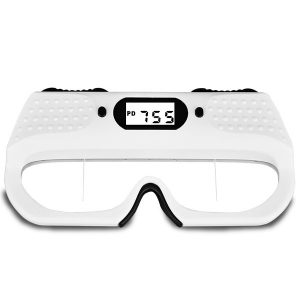 The Direct Digital Pupil Gauge is a simple and inexpensive way to measure both monocular and binocular distances between eyes. This is necessary for accurate fitting of various ophthalmic lenses, especially multi-focals. It works by simply aligning the vertical stripes over the center of each pupillary reflex.
The Direct Digital Pupil Gauge is a simple and inexpensive way to measure both monocular and binocular distances between eyes. This is necessary for accurate fitting of various ophthalmic lenses, especially multi-focals. It works by simply aligning the vertical stripes over the center of each pupillary reflex.

